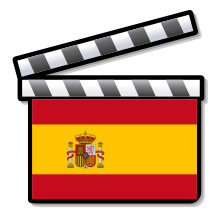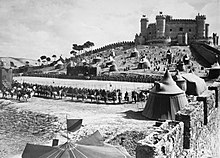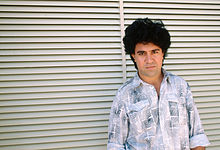Cinema of Spain
This article needs additional citations for verification. (March 2021) |
| Cinema of Spain | |
|---|---|
 | |
| No. of screens | 3,618 (2017)[1] |
| • Per capita | 9.7 per 100,000 (2011)[2] |
| Main distributors | Warner Bros. E. España, S.L. 16.0% Paramount Spain 13.0% Sony Pictures 12.0%[3] |
| Produced feature films (2011)[4] | |
| Total | 199 |
| Fictional | 122 (61.3%) |
| Animated | 9 (4.5%) |
| Documentary | 68 (34.2%) |
| Number of admissions (2017)[1] | |
| Total | 99,803,801 |
| National films | 17,353,734 (17.39%) |
| Gross box office (2017)[1] | |
| Total | €591 million |
| National films | €103 million (17.41%) |
The art of motion-picture making within Spain or by Spanish filmmakers abroad is collectively known as Spanish Cinema.
In recent years, Spanish cinema has achieved high marks of recognition.[citation needed]
Only a small portion of box office sales in Spain are generated by domestic films. The different Spanish governments have therefore implemented measures aimed at supporting local film production and the movie theaters, which currently include the assurance of funding from the main television broadcasters. Nowadays, the
History

The first Spanish film exhibition took place on 5 May 1895, in Barcelona. Exhibitions of Lumière films were screened in Madrid, Málaga and Barcelona in May and December 1896, respectively.
The matter of which Spanish film came first is in dispute.[5] The first was either Salida de la misa de doce de la Iglesia del Pilar de Zaragoza –Exit of the Twelve O'Clock Mass from the Church of El Pilar of Zaragoza– (Eduardo Jimeno Peromarta), Plaza del puerto en Barcelona –Plaza of the Port of Barcelona– (Alexandre Promio) or Llegada de un tren de Teruel a Segorbe –Arrival of a Train from Teruel in Segorbe– (anonymous). It is also possible that the first film was Riña en un café (Fructuós Gelabert). These films were all released in 1897.
The first Spanish film director to achieve great success internationally was Segundo de Chomón, who worked in France and Italy but made several famous fantasy films in Spain, such as El hotel eléctrico (1908).
The height of silent cinema

In 1914, Barcelona was the center of the nation's film industry. The españoladas (historical Spanish epics) predominated until the 1960s. Prominent among these were the films of Florián Rey, starring Imperio Argentina, and the first version of Nobleza Baturra (Juan Vila Vilamala, 1925). Historical dramas such as Vida de Cristóbal Colón y su Descubrimiento de América –The Life of Christopher Columbus and His Discovery of America– (Gérard Bourgeois, 1917), adaptations of newspaper serials such as Los misterios de Barcelona –The Mysteries of Barcelona– (starring Joan Maria Codina, 1916), and of stage plays such as Don Juan Tenorio (Ricardo de Baños, 1922) and zarzuelas (comedic operettas), were also produced. Even the Nobel Prize-winning playwright Jacinto Benavente, who said that "in film they pay me the scraps," would shoot film versions of his theatrical works.
In 1928, Ernesto Giménez Caballero and Luis Buñuel founded the first cine-club, in Madrid. By that point, Madrid was already the primary center of the industry; forty-four of the fifty-eight films released up until that point had been produced there.
The rural drama La aldea maldita –The Cursed Village– (Florian Rey, 1929) was a hit in Paris, where, at the same time, Buñuel and
The crisis of sound
By 1931, the introduction of foreign sound films had hurt the Spanish film industry to the point where only a single title was released that year.
In 1935, Manuel Casanova founded the
The Civil War and its aftermath

The Civil War devastated the silent film era: only ten per cent of all silent films made before 1936 survived the war. Films were also destroyed for their celluloid content and made into goods.[6]
Around 1936, both sides of the Civil War began to use cinema as a means of
The new regime then began to impose censorship and the obligatory dubbing to Spanish to all films released. Highlights in this era are El difunto es un vivo (Ignacio F. Iquino, 1941), Traces of Light (Rafael Gil, 1941), Madness for Love (Juan de Orduña, 1948), Last Stand in the Philippines (Antonio Román, 1945), Raza (José Luis Sáenz de Heredia with screenplay by Franco himself, 1942), and The Tower of the Seven Hunchbacks (Edgar Neville, 1944). Cifesa produced Ella, él y sus millones (de Orduña, 1944) as well as Fedra (Manuel Mur Oti, 1956).
A policy of

On the other hand, starring in popular musical films.
In 1951, the regime instituted the Ministry of Information and Tourism to safeguard and develop the Spanish brand, the social imagery and the public image under the slogan "Spain is different" which was launched in the 1920s and then internationally spread in the 1960s.[9] Its main purpose was to promote the Spanish tourist industry and a massive inflow of people who came from all the Europe towards the Andalusia, looking for what they saw in the Spanish films: sun and sea, comfortable transports and hotels, good ethnic cuisine, passion and adventure, and the so called españoladas (bulls, castanets, flamenco, Gitano culture and folklore).[9] Fog and Sun (José María Forqué, 1951) was the first movies belonging to the genre of the "touristic cinema". It was followed by Veraneo en España (Miguel Iglesias, 1958) and by Spain Again (Jaime Camino, 1969).[9]
Musical films The Last Torch Song (de Orduña, 1957) and The Violet Seller (Luis César Amadori, 1958), both starring Sara Montiel, were huge international commercial successes, making Montiel the first worldwide famous film star –and the highest paid– of Spanish cinema.[10]
Social criticism
In the 1950s, the influence of
Luis Buñuel in turn returned to Spain to film the shocking Viridiana (1961) and Tristana (1970).
Co-productions and foreign productions

A 1954 report by Eduardo Moya from the Ministry of Trade remarked that the Spanish cinema industry had to become competitive at home and abroad. Co-productions with France and Italy could bring the equipment and skills needed.[7]
Numerous
Under the Spanish-American agreements, part of the foreign profits locked in Spain since the war were invested in runaway productions to be distributed abroad. Several American epic-scale superproductions or blockbusters were shot in Spain, produced either by Samuel Bronston, such as King of Kings (Nicholas Ray, 1961), El Cid (Anthony Mann, 1961), 55 Days at Peking (Ray, 1963), The Fall of the Roman Empire (Mann, 1964), and Circus World (Henry Hathaway, 1964); or by others, such as Alexander the Great (Robert Rossen, 1956), The Pride and the Passion (Stanley Kramer, 1957), Solomon and Sheba (King Vidor, 1959), Lawrence of Arabia (David Lean, 1962), Doctor Zhivago (Lean, 1965), The Trojan Women (Michael Cacoyannis, 1971). These movies employed many Spanish technical professionals, and as a byproduct caused that some film stars, like Ava Gardner and Orson Welles lived in Spain for years. Actually Welles, with Mr. Arkadin (1955), in fact a French-Spanish-Swiss co-production, was one of the first American filmmakers to devise Spain as location for his shootings, and he did it again for Chimes at Midnight (1966), this time a Spanish-Swiss co-production.

Warner Bros., an American studio had opened its local headquarters in Spain in the early 1970s under the name of Warner Española S.A. Warner Española, alongside releasing Warner Bros. films (as well as films by Disney theatrically in the late 1980s-90s) is also involved in distribution of Spanish films such as Ensalada Baudelaire (1978), Adios Pequeña (1986) and most of 1990s Pedro Almodóvar's films such as High Heels (1991), Kika (1993), and Live Flesh (1997).
Many international actors starred in Spanish films: Italians
The new Spanish cinema

In 1962,
From the so-called Escuela de Barcelona, originally more experimentalist and cosmopolitan, come Jacinto Esteva, Pere Portabella, Joaquin Jordan, Vicente Aranda, Jaime Camino, and Gonzalo Suárez, who made their master works in the 1980s.
In the Basque country the directors Fernando Larruquert, Nestor Basterretxea, José María Zabalza and the producer Elías Querejeta stood out.
The 1968–1980 period saw the golden age of Spanish B-Movie horror, underpinning the term fantaterror to convey the set of films blending supernatural and horror themes that originated as an answer to European and American exploitation titles.[14]
In the 1960s (and 1970s), a new sort of españolada different from the previous one brought the formulation of an "Iberian" model of masculininity associated to casticismo, represented by a male star system consisting of the likes of José Luis López Vázquez, Alfredo Landa, Andrés Pajares, and Fernando Esteso.[15] A new wave of popular and reactionary mainstream comedy films came to be collectively known as landismo –after Alfredo Landa, a recurring appearance in many of those films playing foreign-women-preying "Latin lover" types–,[16] which was a cultural phenomenon in the 1970s.[17]
The cinema of the democratic era

With the end of dictatorship in the mid 1970s, censorship was greatly loosened and cultural works were permitted in other languages spoken in Spain besides Spanish, resulting in the founding of the Centro Galego de Artes da Imaxe or the Institut del Cinema Català, among others. Also with the end of censorship and repression, a commercial cinema –of low quality and minimal cost– with a high erotic content and gratuitous nudity –mostly feminine– appeared, which was called cine de destape and which lasted until the early 1980s.[18]

In the context of the
During the
The Spanish cinema, however, depends on the great hits of the so-called
Foreign films often dominate box offices in Spain, with average monthly receipts of €35–50 million, making Spain the tenth largest country in the world for international theatrical release, with a total gross of USD 193,304,925 in 2020, thus giving Spain a worldwide market share of 1.8%.[25]
Film Festivals

The
The Sitges Film Festival, now known as the Sitges International Fantastic Film Festival of Catalonia, was started in 1967. It is considered one of the best cinematographic contests in Europe, and is the best in the specialty of science fiction film.
There are several other film festivals with important prizes for the industry such as the Valladolid International Film Festival, and the Seville European Film Festival from September to November, –Autumn has become the season par excellence for the debut of Spanish films in the domestic commercial circuit–.[26] Meanwhile the Málaga Film Festival, focused on Spanish and Ibero-American films, is generally held in early Spring.[27]
Film Awards

The
In 2013,[29] the Feroz Awards were established as the Spanish counterpart of the Golden Globe Awards.
Awards recognising the excellence in the regional cinema (and/or wider audiovisual industry) include the Mestre Mateo Awards (from Galicia; presented by the Academia Galega do Audiovisual),[30] the Gaudí Awards (from Catalonia; presented by the Catalan Film Academy),[31] the Berlanga Awards (from the Valencian Community, presented by the Institut Valencià de Cultura and the Acadèmia Valenciana de l'Audiovisual)[32] or the Carmen Awards (from Andalusia, presented by the Academia de Cine de Andalucía).[33]
English-language Spanish films

English-language films produced by Spanish companies include Two Much (Fernando Trueba, 1995), The Others (Alejandro Amenábar, 2001), The Machinist (Brad Anderson, 2004), Basic Instinct 2 (Michael Caton-Jones, 2006, produced by KanZaman Spain), Goya's Ghosts (Miloš Forman, 2006, produced by Xuxa Produciones), Buried (Rodrigo Cortés, 2010, produced by Versus Entertainment) or The Impossible (Juan Antonio Bayona, 2012, produced by Apaches Entertainment and Telecinco Cinema).
Funding

A large part of the funding of Spanish-produced films is covered in advance of the theatrical window by pre-sales to public (
Box office
Highest-grossing films of all-time in Spain
The ten highest-grossing Spanish films of all time (1965–2023)
| Rank | Year | Title | Domestic gross(million €) |
|---|---|---|---|
| 1 | 2014 | Spanish Affair | 56.2 |
| 2 | 2012 | The Impossible | 42.4 |
| 3 | 2015 | Spanish Affair 2
|
36.1 |
| 4 | 2001 | The Others | 27.3 |
| 5 | 2016 | A Monster Calls | 26.5 |
| 6 | 2007 | The Orphanage | 25.1 |
| 7 | 2003 | Mortadelo & Filemon: The Big Adventure | 22.8 |
| 8 | 2001 | Torrente 2: Mission in Marbella | 22.1 |
| 9 | 2009 | Agora
|
21.4 |
| 10 | 2017 | Perfect Strangers | 21.3 |
See also
- Lists of Spanish films
- Spanish animation
- Media of Spain
- Spanish art
- History of Spain
- Spanish Literature
- Catalan cinema
- Cinema of Galicia
- Sant Jordi Awards
- Cinema of the world
- World cinema
- List of Spanish Academy Award winners and nominees
Notes
References
- ^ a b c "Datos cinematográficos del mercado español" (PDF). Ministerio de Educación, Cultura y Deporte. Retrieved 14 July 2017.
- ^ "Table 8: Cinema Infrastructure - Capacity". UNESCO Institute for Statistics. Archived from the original on 24 December 2018. Retrieved 5 November 2013.
- ^ "Table 6: Share of Top 3 distributors (Excel)". UNESCO Institute for Statistics. Archived from the original on 24 December 2018. Retrieved 5 November 2013.
- ^ "Feature Film Production - Method of shooting". UNESCO Institute for Statistics. Retrieved 19 May 2021.
- ^ "Salida de misa de doce del Pilar de Zaragoza" : la fraudulenta creación de un mito franquista (in Spanish)
- ^ Pavlovi, p. 1
- ^ ISSN 1697-459X. Retrieved 2 March 2021.
- ^ Castilla, Amelia (14 April 2015). "Las fotos de Marisol, niña prodigio del franquismo". El País.
- ^ .
- ^ "Spain's Sarita Montiel Global Allure Makes Her Trading Item With Yanks". Variety. 13 May 1959. p. 21. Retrieved 29 July 2023.
- ^ Marsh, Steven. “The Pueblo Travestied in Fernán Gómez’s El Extraño Viaje (1964).” Hispanic Research Journal 4, no. 2 (2003): 133–49.
- ^ British Film Institute. "Pedro Almodóvar: 13 great Spanish films that inspire me".
- ^ Sally Faulkner (9 January 2017). "Delayed Cinema and Feminist Discourse in Fernando Fernán-Gómez's El mundo sigue (1963/1965/2015)".
- ISBN 978-1-4744-2344-1.
- ISBN 9789052018492.
- ISBN 978-1-4051-9438-9.
- ISBN 978-1-4051-9438-9.
- ^ Barker, Jesse (4 Jul 2018). "Destape: How Spain's erotic cinema of the 1970s shaped its modern society". Scroll.in. Retrieved 30 July 2023.
- ^ Calleja, Pedro (30 August 2006). "El héroe más canalla del Siglo de Oro". Metropoli. El Mundo.
- ^ Castelló Segarra 2018, p. 115.
- ^ Castelló Segarra 2018, pp. 122, 125.
- hdl:10016/28606.
- ^ Castelló Segarra, Jorge (2018). "Cine quinqui. La pobreza como espectáculo de masas". Filmhistoria Online. 28 (1–2). Barcelona: Universitat de Barcelona: 126.
- S2CID 234456586.
- ^ Zannoni, David (26 March 2021). "The Spanish Film Industry for Foreign Producers". Stage 32. Retrieved 18 July 2021.
- ^ Belinchón, Gregorio (27 August 2022). "El otoño del cine en España navega a favor de la corriente". El País.
- ^ G.B (21 March 2018). "A vueltas con lo de la radiografía del cine español". El País.
- ^ "La historia de los Premios Goya". www.premiosgoya.com. 5 December 2019. Retrieved 2019-12-05.
- ^ "Asociación de Informadores Cinematográficos de España". www.informadoresdecine.es (in Spanish). Retrieved 2019-12-05.
- ISSN 1856-1594.
- ^ "El cine catalán entregará los Premios Gaudí, con un trofeo inspirado en La Pedrera". Público. 24 November 2008.
- ^ Camacho, Noelia (29 September 2021). "Berlanga dará nombre a los Premios del Audiovisual Valenciano". Las Provincias.
- ^ "La Academia de Cine de Andalucía presenta los nuevos Premios Carmen del cine andaluz". Audiovisual451. 8 June 2021.
- ^ a b c d Cano, Jose A. (12 September 2023). "Manual para hacer rentable una película española". Cine con Ñ.
- ^ "ORDER of December 22, 1964 establishing the control system of the performance of the films that are exhibited in Spain" (PDF). Boletín Oficial del Estado (in Spanish). 30 December 1964. Retrieved 21 June 2020.
- ^ González, Yolanda (2 February 2019). "Las películas españolas más taquilleras de todos los tiempos". Invertia – via El Español.
- ^ "Las 30 películas españolas más taquilleras de la historia". Fotogramas. 3 August 2023.
Further reading
- Marsha Kinder: Blood Cinema: The Reconstruction of National Identity in Spain, University of California Press, 1993, ISBN 0-520-08157-9
- Marvin D'Lugo: Guide to the Cinema of Spain (Reference Guides to the World's Cinema), Greenwood Pub Group, 1997
- Nuria Triana-Toribio: Spanish National Cinema (National Cinemas Series), Routledge 2002, ISBN 0-415-22060-2
- The Cinema of Spain and Portugal (24 Frames (Paper), ed. by Alberto Mira, Wallflower Press 2005 – 24 films are analyzed
- Ronald Schwartz: Great Spanish Films Since 1950, Scarecrow Press, 2008
- Tatjana Pavlovic: 100 Years of Spanish Cinema, John Wiley & Sons, 2008
- Juan Antonio Gavilán Sánchez y Manuel Lamarca Rosales: Conversaciones con cineastas españoles, Servicio de Publicaciones de la Universidad de Córdoba, 2002. ISBN 9788478016112.
- Manuel Lamarca y Juan Ignacio Valenzuela: Cómo crear una película. Anatomía de una profesión, T&B Editores, Madrid, 2008. ISBN 9788496576766.
External links
- Top 10 movies from Spain according to IMDB.com
- Discussion of 10 key films in Spanish cinema at subtitledonline.com
- Ministry of Culture of Spain, Cinema Web
- Official website of Viva Pedro series celebrating the films of Pedro Almodovar
- Spanish movie reviews
- Silver Screen Spain. Information about shooting locations around Spain of English-language movies.
- Spanish film reviews in English
